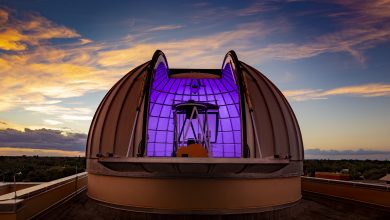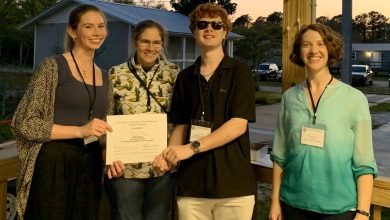From 5,300 to 13.8 Billion: The Age of Our Universe
Artist’s rendition of the Big Bang from How Stuff Works.
The first public physics lecture of the semester was given by Dr. Batcheldor. It was called “The Age of the Universe.” Dr. Batcheldor started out by explaining that in order for us to figure out the age of the universe, we would have to look for the oldest things we could find, and we would at least know the universe was older than that. First we found the oldest things we could: Sumerian cuneiform from 5,300 years ago, a piece of jewelry called Venus of the Hohle Fels from 35,000 years ago, and the oldest homo sapien remains, which date back to 195,000 years ago.
We know this from a process called radiometric dating. Radioactive materials take a certain amount of time to decay into another element, so when we find an old object we can see what radioactive elements are present and how much of its decayed counterpart is also present. Using known half-lives of these radioactive elements (a half-life is how much time it takes for half of the radioactive atoms to decay), we can then calculate how many years it took to result in the observed ratio of radioactive and decayed particles. Dr. Batcheldor used an example of ice turning into water to demonstrate this ratio technique and how we know the half-lives of the radioactive elements. Using a mass spectrometer, he weighed an ice cube and left it out to melt, with the water sliding onto a separate mass spectrometer. He recorded both weights at various times throughout the experiment, which he then plotted. The resulting graph is an “X” shape, the place where the two slopes intersect being the half-life of the element.
Radioactive Decay graph courtesy of Georgia Perimeter College
Eventually Uranium-238 was determined to have a half-life of approximately 4.5 billion years. The oldest rocks found on Earth had some of this present, meaning the Earth is about that age. The Sun was then determined to be about 4.57 billion years. Coincidence? I think not! The Sun’s age was determined by figuring out how much energy it emits and then trying to find a process that would allow something with the Sun’s mass to stay so bright for so long. Hydrogen fusion was the best fit, and from using spectrometry we were able to see the ratio of hydrogen and helium currently in the Sun. Calculating backward gave us the Sun’s age.
Looking beyond our solar system, astronomers found what we now call white dwarfs, stars at the end of their lives and in the process of cooling. The amount of energy being emitted by these dying stars can tell us how long they have been cooling. Since we know the approximate length of time it takes a star to reach white dwarf stage, we can conclude how old they are. For example, the Messier 4 cluster is about 12.2 billion years old.
We can also compare our galaxy’s observed velocity with other galaxies, which showed us the further away we looked, the more the spectra of these other galaxies appeared to shift toward the red end of the spectrum. Shifting of the spectra, coined “redshift,” indicates the galaxies are moving away from us (if they were moving toward us we would see a “blueshift”). This is similar to the Doppler effect except for electromagnetic radiation rather than sound waves. Edwin Hubble is credited with first figuring out the redshifts observed were not only caused by the Doppler effect, but they were also related to the distances between us and other galaxies. The light was traveling so far that it was literally being stretched before reaching us, a phenomenon now called the cosmological redshift and given by the Hubble constant (the rate at which the galaxies are accelerating away from us).
Artist’s rendition of a quasar surrounding a black hole from Wikipedia
From some observations of the redshift of quasars (the area around the super massive black holes at the center of galaxies), we found out the ratio of hydrogen and helium found between us and the quasars is a lot higher than we first thought, meaning the universe must have started out a lot hotter and denser than originally assumed. Working backward from what we can see now, the extremely hot and dense early universe should have been about 3,000 K. We should be able to find the signature of such a hot and dense beginning, so we started looking around us and found the cosmic microwave background radiation (CMB) detected by the COBE telescope in 1989. The temperature of the CMB is only about 2.74 K when it should be 3,000 K, meaning it has been redshifted a lot and much time has passed for it to be so spread out. Other telescopes have done a more in depth study of the hot and cool spots found in the CMB since then, and our current best estimate of the age of the universe is 13.8 billion years!
What I really like from this talk is the idea of how science progresses. All of those other things had to be discovered and used before we could find the CMB and use it to determine how long our universe has been around. Scientists base their experiments on known theories, and when an observation doesn’t seem to fit, many people pitch in to try and figure out a way to explain the phenomenon within those theories. Eventually, when enough evidence has been collected, the world is introduced to something new, something that the human race had never considered before. Anyone who says we have discovered everything in this world is not in tune with the scientific community. Everyone should try to keep an open mind and let the evidence in front of them take them where it will!







